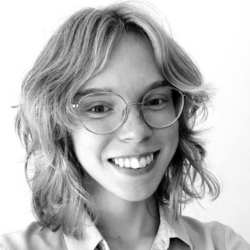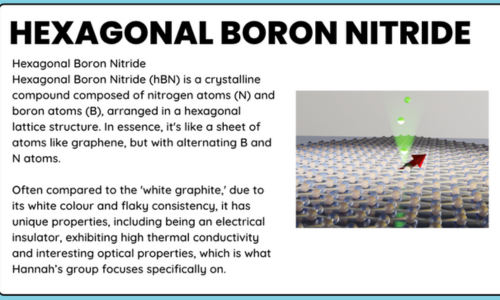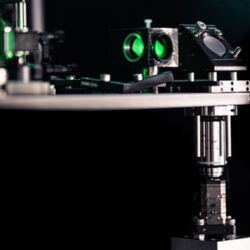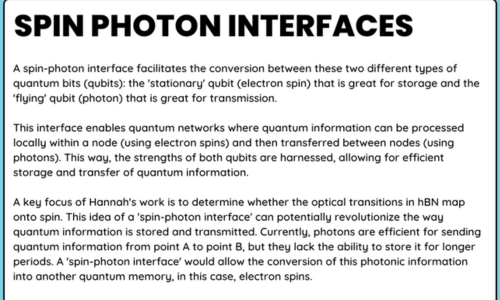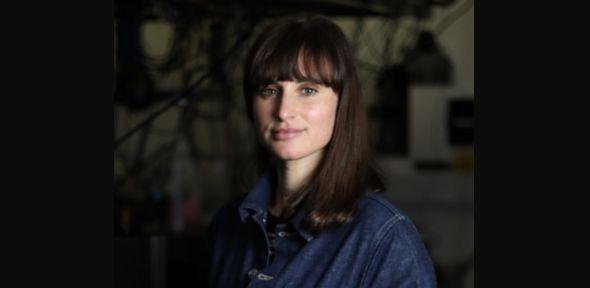
This blog is part of an interview series by Tara Murphy.
|
Tara Murphy I’m Tara, a NanoDTC student here at the Cavendish Laboratory in the University of Cambridge. Since arriving here last year, I’ve come to realise the exceptional work being carried out by the brilliant women at the Cavendish Laboratory and I think it’s crucial to bring attention to the remarkable achievements and invaluable contributions of these women, both past and present. Join me, as I sit down with the remarkable women of Cavendish Laboratory, delving into their personal journeys, research interests, and experiences in the scientific community. This week I spoke with Dr. Hannah Stern whose research focuses on quantum optics and mesoscopic systems. In this interview, she shares with us her inspiring journey from studying law and science in New Zealand to becoming a leading researcher in quantum materials at Cambridge! |
Interview with Dr. Hannah Stern
|
Can you share with us your early days at university and how you decided on your field of study? Certainly! I began at university in New Zealand, where students are allowed to study a range of subjects before choosing a major. Initially I studied law and science, but I was immediately drawn to chemistry and physics lectures, and eventually I decided to major in chemistry. I had a particular interest in physical chemistry, specifically in spectroscopy and quantum mechanics. |
|
I never knew you initially studied law! Now, could you walk us through the steps that led you from New Zealand to Cambridge? After finishing my undergrad, I felt the need for a break from studying so I started working as a hiking guide on the Milford Track (a multiday trip in Fiordland New Zealand). It was a really transformative period, I was constantly meeting new people. One of them happened to be an academic from Cambridge and the conversations I had with him motivated me to apply to Cambridge for a PhD. I was fortunate to get accepted, and even more fortunate to receive a Winton Scholarship! |
|
Moving on to your PhD, could you elaborate on the kind of work you were doing? My PhD, under Richard Friend's supervision, focused on the ultrafast photophysical processes in organic semiconductors. The central question we were trying to answer was: How does a particular photophysical mechanism that we know exists in organic chromophores (singlet exciton fission) proceed? This was important because understanding this mechanism may help to design more efficient solar cells. To address this, we had to integrate various optical techniques that provide different pieces of the puzzle over different time scales. This was very different to what I studied in my undergraduate, it was ultimately a Physics PhD, and I studied chemistry! There were definitely times during my PhD when I felt that my chemistry background was perhaps a disadvantage, but looking back, I value the broad base that my academic journey provided me. |
|
Wow, that’s incredibly interesting Hannah! Can you share with us your transition from PhD to Junior Research Fellowship at Trinity College? Well, while I was in the final stages of writing my thesis, I decided to apply for the Trinity College Junior Research Fellowships, and I was thrilled when I got offered! However, I knew I wanted to explore new directions from my PhD, whilst retaining a link to spectroscopy and spin physics of optical materials. Ultimately, inspiration came from a unlikely source : one day I saw a lecture from a visitor from EPFL who presented a talk about imaging defects in hexagonal Boron Nitride (hBN) using super-resolution imaging techniques. This sparked my interest, and I started experimenting with hBN samples. |
|
That brings us to your current research. Can you tell us more about it? My research focuses on understanding a two-dimensional material, hexagonal Boron Nitride (hBN), that hosts isolated quantum objects— atomic scale impurities, or defects, with well-defined optical and spin transitions. These systems are sometimes referred to as ‘artificial atoms’ and are a resource for quantum technologies, for example for sending and storing quantum information in an optical network or for sensing magnetic fields with nanoscale spatial resolution. The defects we have discovered in hBN are particularly interesting because they show promising optical and spin properties at room temperature, which is unusual for defects in solid-state materials. A room temperature confocal microscope |
|
Could you explain the first question you wanted to answer about hBN? The initial question we were dealing with was whether the single photon emitting defects in hBN are also a spin-photon interface. To answer this, we used optically detected magnetic resonance. This enables us to optically detect the presence of single electronic spin transitions. Using ODMR, we observed that the number of photons emitted per second by a single defect in hBN can be modulated by up to 30% due to driving the electronic spin using microwaves, at room temperature. This result is exciting because it revealed a room-temperature spin-photon quantum interface in a 2D material, which opens lots of opportunities for future work. |
|
That's remarkable! What other explorations are you undertaking with hBN? We have recently built on this initial discovery by showing we can coherently control the electronic spin state for single defects, which is critical for putting this system to use as a spin qubit. It took us some time to get from our first observations of ODMR to our demonstration of coherent control. This is because (as is the case with working with a brand new material system) we had to first identify the true ground state spin resonance, which incidentally wasn’t the first signal we measured. The true ground state resonance had not been identified before and we were the first to find it. Ultimately, this finding unlocked the ability to drive Rabi oscillations and determine the spin coherence time, which is surprisingly long at room temperature (several hundred nanoseconds, extendable to several microseconds), considering this material is also full of nuclear spins. |
|
How do you see the future of this research? This discovery has opened new avenues for research in hBN, specifically opportunities to apply these spin qubits to quantum network and quantum sensing applications. Me and my co-workers in the Cavendish including Dr Carmem Gilardoni, Simone Eizagirre Barker, Oliver Powell, Stephanie Fraser, Xiaoxi Deng and Prof Mete Atature are eagerly exploring these opportunities. |
|
Your journey certainly inspires many, Hannah. Can you share any advice for students who are just starting their journey in scientific research? I would encourage new students to try to maintain a sense of general curiosity - attend advertised talks and ask lots of questions about other people’s research. Sometimes new research ideas and opportunities come unexpectedly. |
Know more about Hannah Stern's research
Banner Image: Hannah Stern
Image Credits: Hannah Stern & Tara Murphy

